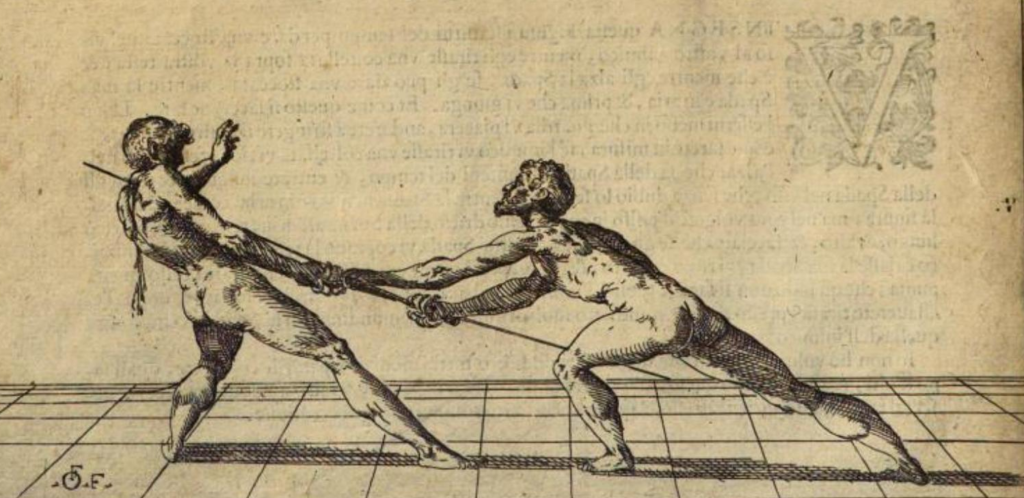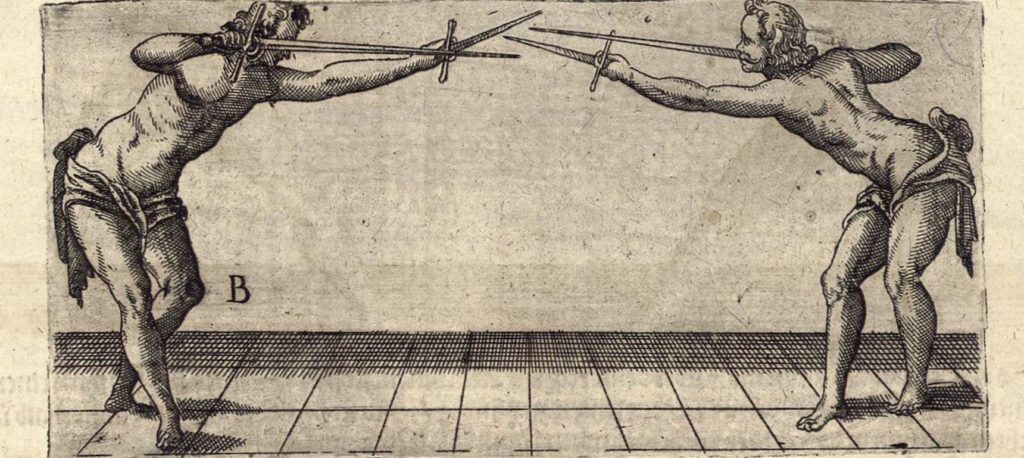Tento článok je v angličtine. Preložte ho kliknutím sem.
Another entry in the Learn Rapier video series – this time about about footwork in historical Italian rapier.
Alfa and Omega are the first and the last letters from the classical Greek alphabet. They’re often used to symbolize that something is both the beginning and the end. And in fencing, everything starts and ends with footwork.
THE MYTH OF HEMA FOOTWORK
If there was a myth about historical fencing that we should debunk and get rid of in the first place, it certainly would be the concept of HEMA being slow, clumsy and laborious. That is not true. Often it serves as but an excuse to people who are lazy to do some proper practice.
Our ancestors were exquisitely athletic – we have so much pictorial and textual evidence since as far we can remember and dug. So no more talking and excuses and let’s get to work!
FIRM FOOTED ATTACK
A firm footed attack is a term our ancestors used for two kinds of actions – a standard lunge or – as the name suggest – for attacking just by bending the body forward without any movement of the feet.
I chose the first exercise in this video to be of the static lunge. People often end up very close to each other, either by mistake or as a part of someone’s tactics. But let’s be honest, distance management is quite an issue in modern HEMA and if you know how to keep your distance you don’t need much to be successful in sparring.
When you realize that you are in such distance that you could hit your opponent without passing, don’t hesitate. Extend your arm and bend your body fully forward to acquire reach. This also works as punishment for those fencers who step into close distance without threatening you.
THE LUNGE
Fabris says that the firm-footed attack was in its both appearances the most common attack in duels. Seeing as the lunge became prominent from his time on there is no doubt his statement is right.
Firm-footed attacks require a lot of practice to master. It’s not easy, if you’ll do it correctly your muscles will burn but once you master it you’ll realize how much advantage they can give you in a fight.
If you want to be successful in fencing not just by mere coincidence, do not forget the following: when attacking with a simple, direct attack, ALWAYS EXTEND YOUR ARM WITH YOUR BODY FIRST.
The thing is, the movement of your hand and arm is so small that it’s much harder for your opponent to react to it. The stimulus for their eyes is very small. The more you limit your movement, the more you utilize just a simple, direct extension towards your target, the bigger the probability that you’ll hit or that you’ll make your opponent parry instead of counterattacking.
When your whole body moves, it gives your opponent a signal that something’s going on. Of course, there are certain occasions when you move with body first, e.g. when you make use of psychology, feinting and fear, but that is a topic for a different time.
But remember – your primary practice of the lunge should be about extending arm first, about precision, pragmatic movement, covering huge distance and working with various dynamics of movement in general.
ADVANCE AND RETREAT
A lunge will certainly help you to reach your opponent. But as Lichtenauer says:
He who moves is alive, he who does not move is dead.
A simple witty statement means that we should move and be in motion against are opponent. Unless we possess a great mastery, it’s always a risk just to stay and wait for our opponent’s move.
Thus we should be well practiced in advancing and retreating and from launching dynamic lunges from such movement.
Usually, an advance should be done with the front foot leading and the rear one stepping behind. In some situation, namely when we’d like to fake our actual reach we can just get our rear foot just behind our front and from there we can attack further than we could just by a standard lunge.
Generally, in rapier we should prefer rather narrow stances than the deep ones. At least when we speak about initial guards and before commencing our attack. From a narrow stance we can always launch a deeper attack as we could from a deep one.
However, if you’re well practiced and used in doing wider stances, you should have no issues to utilize them as well. Just be wary of the attacks to the legs.
PASS WITH THE LEFT FOOT
In single rapier, the pass with the left foot should be done just by pushing the still-turned left leg a bit forward in front of the right one. Furthermore, during such a movement we should not turn our left side towards the opponent but we should still keep our right forward.
If you learn how to pass with the left foot in this manner you will see that it’s even much easier to do the following step with the right foot. In such way, you can then run towards your opponent if necessary. This is very useful when performing passes underneath their blade or when you’d like to approach them very safely but still having and huge reach in your attack.
Since Fabris teaches the body to be well bend forward a pass with the left foot becomes much more natural because the weight of the body is still situated on the front foot.
GIRATA
What makes Fabris‘ school different and also revolutionary compared to other contemporary authors is not only the complexity and finesse of his work, but also his specific movement. As you might have noticed, Fabris‘ says that the best way how to approach people with rapier is by having your body completely bend.
On the first look it looks weird, but when you get into it you’ll realize how ingenious it is. What it actually does it limits the target you offer to your opponent just to a very small portion of your whole body. Also, it prolongs your reach and strengthens your attacks. And last but not least, it looks nice, doesn’t it? J
A girata means in Italian a turn or turning. In certain actions, all we need to void the opponent’s attack is just get our body out of way by turning it away from the attack. Such actions can be done just by stepping out of line by either feet to both sides, depending on the attack and tempo.
These giratas can be also used offensively as we will see in some assaults in another videos.
RAPIER AND DAGGER
Rapier and dagger is a fantastic combination which has its unique rules. For instance, unlike in single rapier we can make use of the left-leg-forward stance and also of some other peculiar stances and movement.
Also a much greater control of the positioning of the body is required. This time we need to coordinate two weapons. And if you’ll know how to do it properly you’ll see that in the end considerably less energy is needed to successfully execute a defense or an attack. In the end, in rapier, everything is just about angles and proper positioning.

